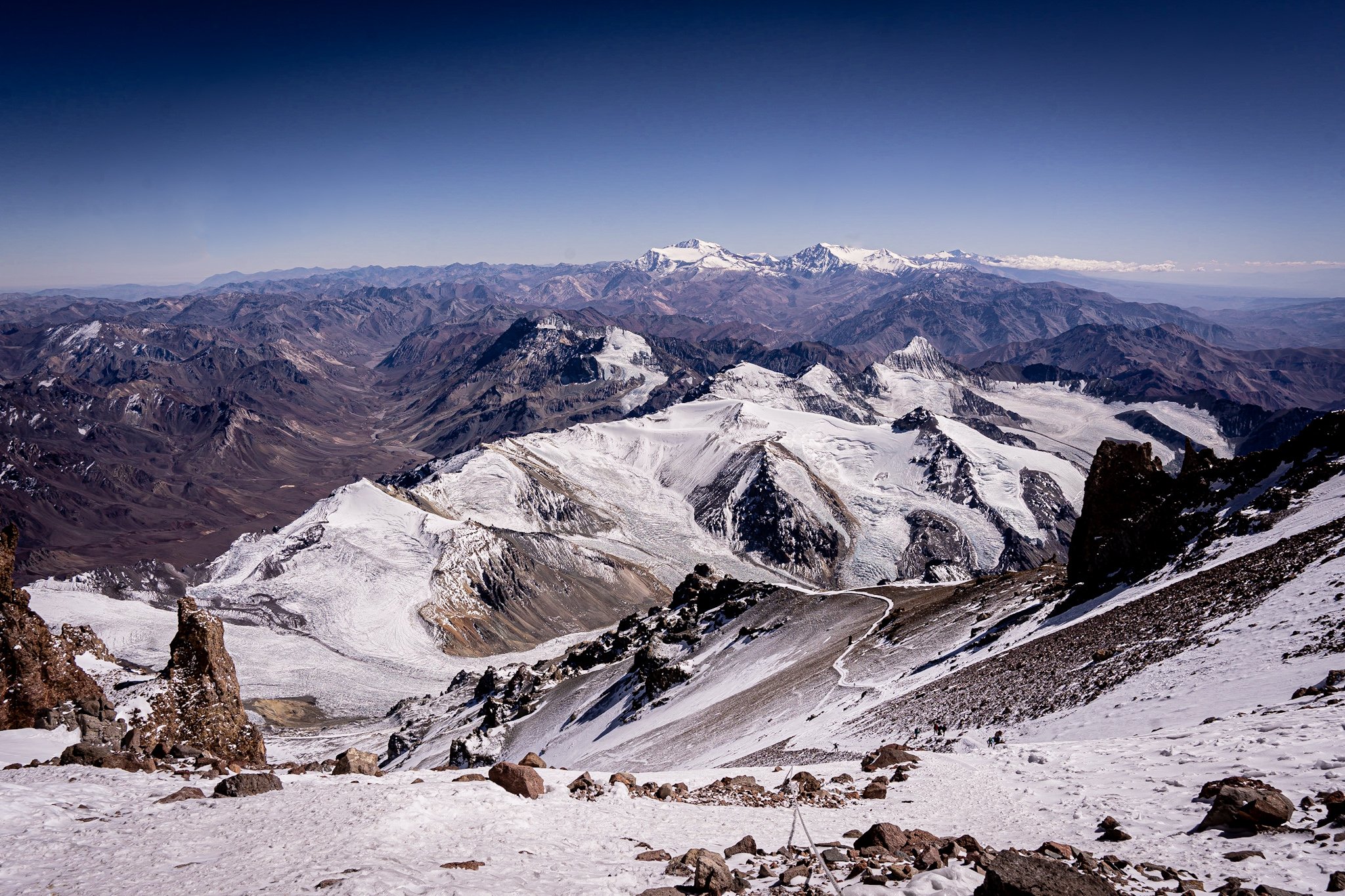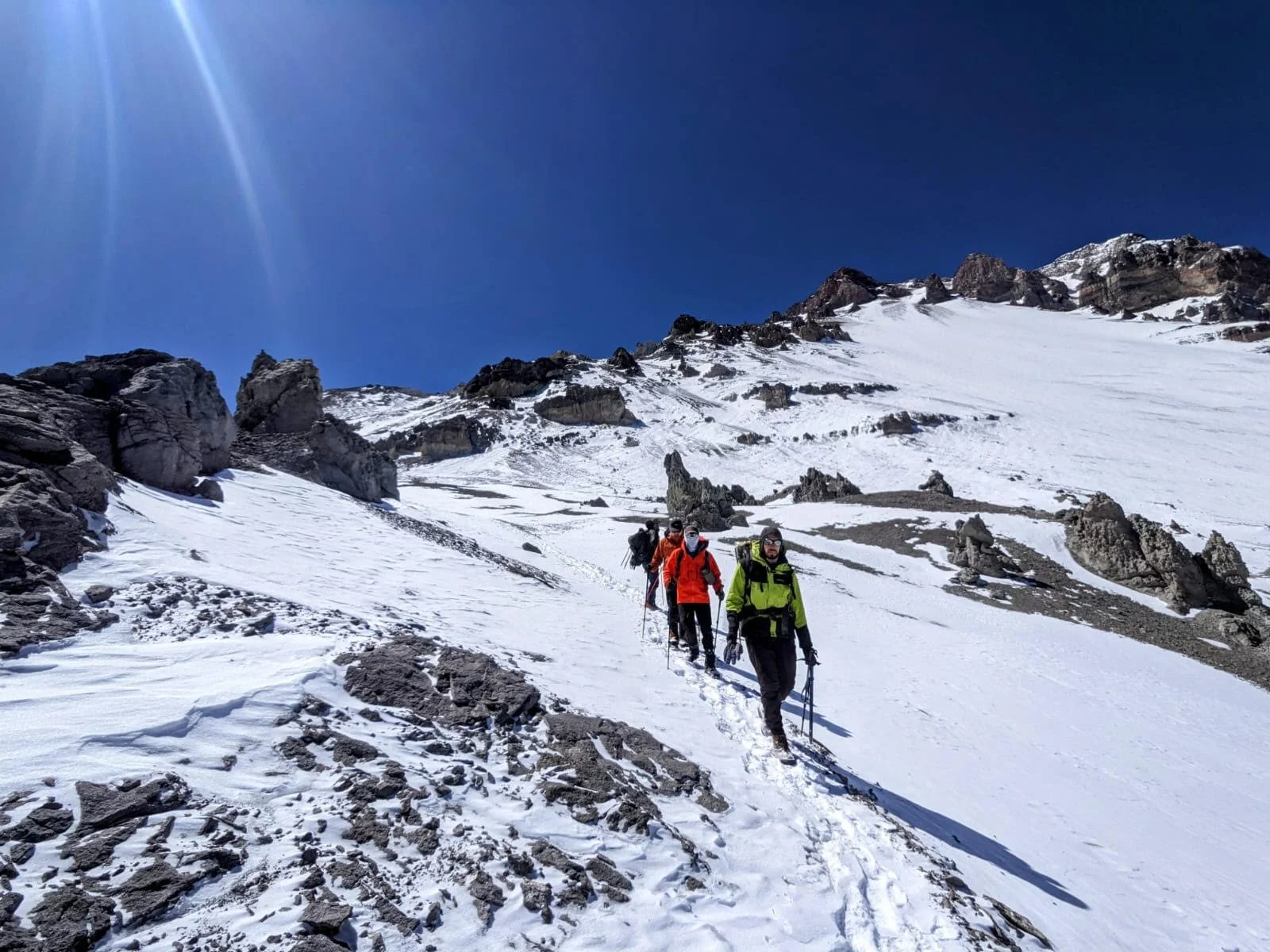THE SUMMIT BID OF ACONCAGUA
THE SENTINEL OF STONE
Aconcagua is a mountain located in Argentina and is the highest peak of South America. It is sometimes referred to as the Stone Sentinel and stands at a whopping 6,691m / 22,838 ft above sea level. An expedition up Aconcagua takes approximately three weeks to complete.
THE SUMMIT PUSH
The vibrations from my watch alerted me that it was 3am and time to wake up. The truth was that I never actually slept to begin with. Alpine starts are never easy as sleeping in altitude is difficult in of itself, but when coupled with anxiety of the summit uncertainty, actually being able sleep is never likely to work in your favor. As I got dressed into my summit gear, it hit home with both excitement and nervousness that this would be my last day of ascent following a long and arduous few weeks of climbing. I was ready.
The summit push would, broadly speaking, be broken up into three parts. Camp Colera to Indepencia; Indepencia to the Cave; the Cave to the Summit. The estimated time to complete these three legs including the descent back to high camp was predicted to take 16 hours, however this was largely dependent on our team’s pace. With headlamps on and crampons secured, our climbing team of seven set off into the night. The game plan was the same as we had practiced each and every day of the expedition leading up to this moment. Single file, slow and steady steps, relaxed and controlled breathing. The only difference today was that we would continue these techniques all the way to the very top of the mountain.
It would take approximately four hours of walking towards Indepencia, through the cold and harsh elements of the mountain’s night, when something would start to feel off. It’s hard to put these feelings into words, but I began to feel a sense of disconnectedness from the world around me. My body didn’t necessarily feel fatigued, nor was experiencing signs of exhaustion, but there was something in my mental state that felt disassociated from my physical body. I could see and feel my legs moving, but it did not feel like I was commanding them to walk. Similarly, I could hear myself speak, but I did not feel like I was in control of what was being said. It was an extremely scary feeling and was the byproduct of the lack of oxygen flowing to my brain. I was starting to become extremely hypoxic.
By the time we reached Indepencia, I was beginning to get worried. I could not shake the feeling of disassociation and it wasn’t clear to me at the time what was causing it, nor how to make it go away. I was given two options by a guide after expressing to him my concerns. Continue with the climb or descend back to camp. At that point in time I was not willing to concede, so I signaled to him that I would continue. My mind at this stage felt like it was floating away and that I was slowly starting to lose grip of reality. It would take every bit of concentration to drag it back into some semblance of normalcy however it would not be long before it started to drift away again. It would take another 4 hours to finish the next section of the ascent, reaching the penultimate stop of the total push; “The Cave”. In the state I was in, the trek up to this point had been an absolute grind.
We would eventually reach the Cave, however now things had only intensified. While the team rested for a quick water and snack break, I wrestled with the critical decision I was faced with. Was it too risky to go on? Or was it al simplyl in my head? My body physically felt fine. Admittedly I was one of the stronger climbers in our group; I had always been second in line throughout the expedition (the line was ordered from strongest climber to weakest), however this was far beyond a lack of physical endurance. Stubborn and not willing to give up just yet, I decided once again to press on. I laboriously started my ascent from the Cave up the steepest but final part of the mountain. By this stage, my symptoms had exponentially magnified. Every step I took now felt unstable. The control over my mind felt like it was quickly dissipating into blurriness. For the first time throughout this ordeal, dizziness would also begin to ensue. I tried to push through it as best as I could, one wobbly step at a time, and while my heart told me to go on, my head screamed for me to consider my actions carefully. We were about 20 minutes into the next and final section of the climb (approximately 6600m above sea level according to my watch) when I signaled to the group that I had to stop, a mere 400m shy from the summit. I knew what I was about to give up, I knew what it meant to be so close yet so far. But I also knew the downsides of continuing to ascend could be much, much worse. It was at this point that I deemed it too risky to go on. I made the call and I followed my head. I decided that I was going to go back down.
THE DESCENT
The descent down the mountain was a blur. Still trying to get a grip of my mental state the entire trek down, reaching high camp three felt almost like an impossible task to complete. Both my steps and breathing were labored. My feet now dragged heavily through the snow, each step felt like my legs weighed a tonne each. Although I had the somewhat simple task of maintaining concentration and placing one foot in front of the other, my focus only continued to lapse and I found myself having to continuously force my mind back to reality. I recall only taking a single break on the way down, which coincidentally happened to be Indepencia; the stop I had originally considered turning around at earlier in the night. It was, however, far from nighttime at this stage and the sun beamed down ferociously. The guide helping to walk me back seemed uncharacteristically quiet on the way down, somewhat of a contrast to her usual, bubbly self which I had gotten to know well over the past few weeks. In hindsight I could only think of a few reasons for her behavior; 1) she knew I was in no shape to actually have a coherent conversation, so she left me alone; 2) she was a bit resentful that I had made her turn back, 400m away from what would have been her first summit; or 3) she was actually as cooked as I was. Either way, for the rest of the way back, we both plodded along in silence. To say I had to dig deep in order to concentrate would not do it justice. The exercise of putting one foot in front of the other was an incredibly more difficult task than it should have been. In fact, in my state of deliriousness I had managed to trip over myself and face plant numerous times along the way back. My pants became a casualty of these falls from my crampons piercing through its fabric and would later become unsalvageable. At the time though, I didn’t care. All I cared about was reaching camp so that I could rest and get my brain functioning properly again. My legs were on auto pilot but my mind seemed to be in another dimension. However, after what seemed to be a never ending walk we eventually made it back to high camp three; four hours after leaving the Cave. After struggling to string together a coherent “thank you” to my guide, I B-Lined straight to my tent to lie down. There was a sense of paranoia that loomed in the air from the hypoxia and the world was still spinning around me. I knew, however, I was now in lower altitude and the oxygen levels here were elevated, relative to where I had come from. My body was exhausted, my blood oxygen had dwindled and I was completely sleep deprived. It didn't take long for me to fall into a deep and much needed sleep.
THE RETURN TO MENDOZA
Of our entire group of eight climbers (excluding our three guides), four ended up making it to the top of Aconcagua; a 50% success rate. Sharing stories of our individual experiences of the summit push, we would learn one of our team members, upon reaching the top, had become dangerously delirious as well. He needed to be short roped (tethered) to the guide on the way down for his own safety. Additionally, we learnt that another trekker from a different expedition was also so hypoxic that he was unable to walk by the time he reached the Cave. He needed to be fed supplemental oxygen as his motor functions continued to diminish. He even had to be slapped a few times in order to keep him awake as falling asleep in his state could potentially have been fatal. My understanding is, however, that he eventually made it down the mountain safely. Such stories were reminders to us of the realities and perils associated with mountaineering adventures. Such adventures that we all were willing to voluntarily participate in.
Following the day of our summit bid and departing from high camp three, It would take our team another 2 days to descend all the way back down the remainder of the mountain. We would continue to trek until we reached the national park’s entrance where a minibus was waiting for us to drive us back to Mendoza. As we exited the park for the journey back from mountain to city, there was a strange ambiance in the air. It was strange being back in civilization. It was strange seeing cars surrounding us as well as seeing other people apart from our team; the group of people who we had shared the past 3 weeks with at virtually every waking moment and whom we now called friends and comrades. It was strange hearing the noises of the city as well as the smell of pollution in the air; something once familiar but now seemingly foreign after being isolated up a mountain and amongst both nature and the elements for the duration of our trip. It was strange to face reality again and digest everything that we had just been through; all the adventure, the drama, the emotions and the highs & lows had now come to an end. A trip that had been nearly 12 months in the making had reached its conclusion. The expedition was finished. Our Aconcagua trip was over. It was time to go home.
THE REFLECTION
As I write this, exactly one year on from the trip, I do sometimes look back to reflect on the expedition and wonder “what if”. What if I had pushed myself just a little bit further. What if I wasn’t in as much risk as I deemed myself to be at the time. What if I actually had reached the summit. No doubt it would be nice to have claimed the peak and ticked off another one of the seven summits however as I look back, I am actually proud of myself. I’m proud of the responsible decision making to turn around 400m shy of the top. I’m proud that I did not let summit fever and ego get the better of me. I’m proud that I am able to realize this and appreciate the fun of the expedition in its entirety despite the failed summit. Deciding to descend before the top was the rational thing to do and the correct decision to make. I turned early, I failed to summit Aconcagua and I am ok with it. As the great mountaineer Ed Viestures once said, “Getting to the top is optional however getting down is mandatory”.


